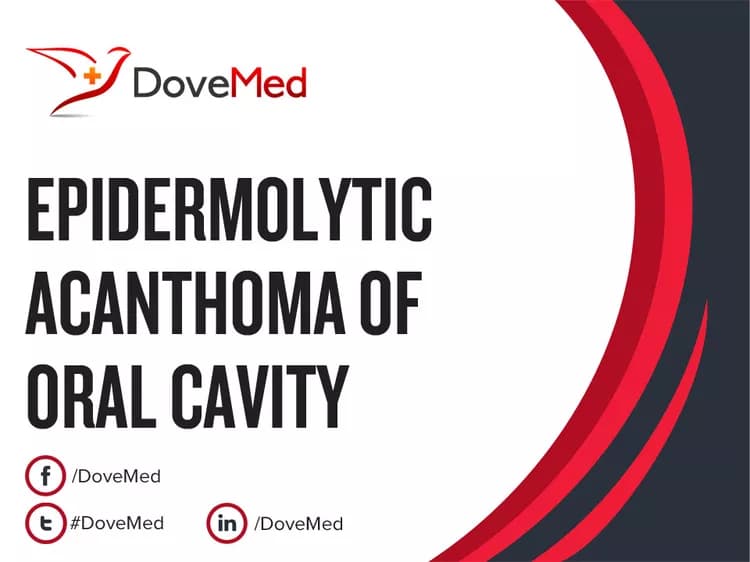What are the other Names for this Condition? (Also known as/Synonyms)
- Epidermolytic Acanthoma of Mouth
What is Epidermolytic Acanthoma of Oral Cavity? (Definition/Background Information)
- Epidermolytic Acanthoma of Oral Cavity is a benign tumor that occurs in the mouth (oral mucosa)
- It is an uncommon condition that occurs in the mouth as a painless, elevated papule. It can occur in a wide range of individuals including young children and elderly adults
- The cause of Epidermolytic Acanthoma of Oral Cavity is generally unknown; although the risk factors include ultraviolet light exposure and chewing of tobacco
- In a majority of cases, no treatment is necessary, unless it causes worrisome symptoms in the individual, such as eating and swallowing difficulties
- A simple surgical excision of the lesion is considered curative. The prognosis for Epidermolytic Acanthoma of Oral Cavity is excellent with suitable treatment
Who gets Epidermolytic Acanthoma of Oral Cavity? (Age and Sex Distribution)
- Epidermolytic Acanthoma of Oral Cavity is a mucosal tumor that may occur in a wide age range (3-80 years); both children and adults may be affected
- Both males and females may be present with the tumor
- Individuals of all racial and ethnic background may be affected. Worldwide, no geographical localization has been reported
What are the Risk Factors for Epidermolytic Acanthoma of Oral Cavity? (Predisposing Factors)
Currently, the following risk factors have been identified for Epidermolytic Acanthoma of Oral Cavity:
- Prolonged sun exposure, exposure to ultraviolet (UV) light
- Use of tanning beds, tanning parlors
- Injury to the skin
- Smoking and tobacco chewing
It is important to note that having a risk factor does not mean that one will get the condition. A risk factor increases ones chances of getting a condition compared to an individual without the risk factors. Some risk factors are more important than others.
Also, not having a risk factor does not mean that an individual will not get the condition. It is always important to discuss the effect of risk factors with your healthcare provider.
What are the Causes of Epidermolytic Acanthoma of Oral Cavity? (Etiology)
- The cause of development of Epidermolytic Acanthoma of Oral Cavity is unknown. Some researchers believe that it may be due to exposure to sunlight
- Genetic mutations have been detected in some cases, which are currently being characterized
What are the Signs and Symptoms of Epidermolytic Acanthoma of Oral Cavity?
The signs and symptoms of Epidermolytic Acanthoma of Oral Cavity include:
- It may occur as a single or multiple raised papules. A papule is an area of abnormal skin tissue elevated above the surrounding skin or mucosa that is less than 1 centimeter across. Usually a papule has distinct borders, and it can appear in a variety of shapes
- It is slow-growing and may range in size from 2 mm to 2 cm
- This papule is usually painless and non-itchy
- The mouth parts affected may include the lips, tongue, cheek, hard and soft palate, gums, etc.
- Due to the presence of the lesion on the oral mucosa, it may be difficult for the individual to consume food and drink. Also, speaking may be difficult and painful
How is Epidermolytic Acanthoma of Oral Cavity Diagnosed?
A diagnosis of Epidermolytic Acanthoma of Oral Cavity may involve the following:
- A thorough medical history and physical examination
- Dermoscopy: It is a diagnostic tool where a dermatologist examines the skin using a special magnified lens
- Wood’s lamp examination: In this procedure, the healthcare provider examines the skin using ultraviolet light. It is performed to examine the change in skin pigmentation
- Skin biopsy: A skin biopsy is performed and sent to a laboratory for a pathological examination. The pathologist examines the biopsy under a microscope. After putting together clinical findings, special studies on tissues (if needed) and with microscope findings, the pathologist arrives at a definitive diagnosis
Many clinical conditions may have similar signs and symptoms. Your healthcare provider may perform additional tests to rule out other clinical conditions to arrive at a definitive diagnosis.
What are the possible Complications of Epidermolytic Acanthoma of Oral Cavity?
- Epidermolytic Acanthoma of Oral Cavity is an uncommon and benign tumor. It does not cause any significant complication
- Severe discomfort while eating, chewing, or swallowing food
- Emotional and psychological stress
How is Epidermolytic Acanthoma of Oral Cavity Treated?
The treatment of Epidermolytic Acanthoma of Oral Cavity may involve the following:
- In a majority of cases, removal of the tumor is not necessary, unless it causes bothersome signs and symptoms such as severe discomfort while eating or drinking
- The treatment of choice is a complete surgical excision, which results in a cure
How can Epidermolytic Acanthoma of Oral Cavity be Prevented?
Currently, there are no known methods to prevent Epidermolytic Acanthoma of Oral Cavity occurrence. However, some of the risk factors may be recognized and controlled. These include:
- Maintain proper oral hygiene
- Avoid chewing tobacco and smoking
- Avoid or minimize sun exposure
- Limit the use of tanning beds, tanning parlors
What is the Prognosis of Epidermolytic Acanthoma of Oral Cavity? (Outcomes/Resolutions)
The prognosis for Epidermolytic Acanthoma of Oral Cavity is excellent with appropriate treatment, since it is a benign tumor.
Additional and Relevant Useful Information for Epidermolytic Acanthoma of Oral Cavity:
There is no evidence to prove that the intake of certain foods have an influence on epidermolytic acanthoma development.
Related Articles
Test Your Knowledge
Asked by users
Related Centers
Related Specialties
Related Physicians
Related Procedures
Related Resources
Join DoveHubs
and connect with fellow professionals



0 Comments
Please log in to post a comment.